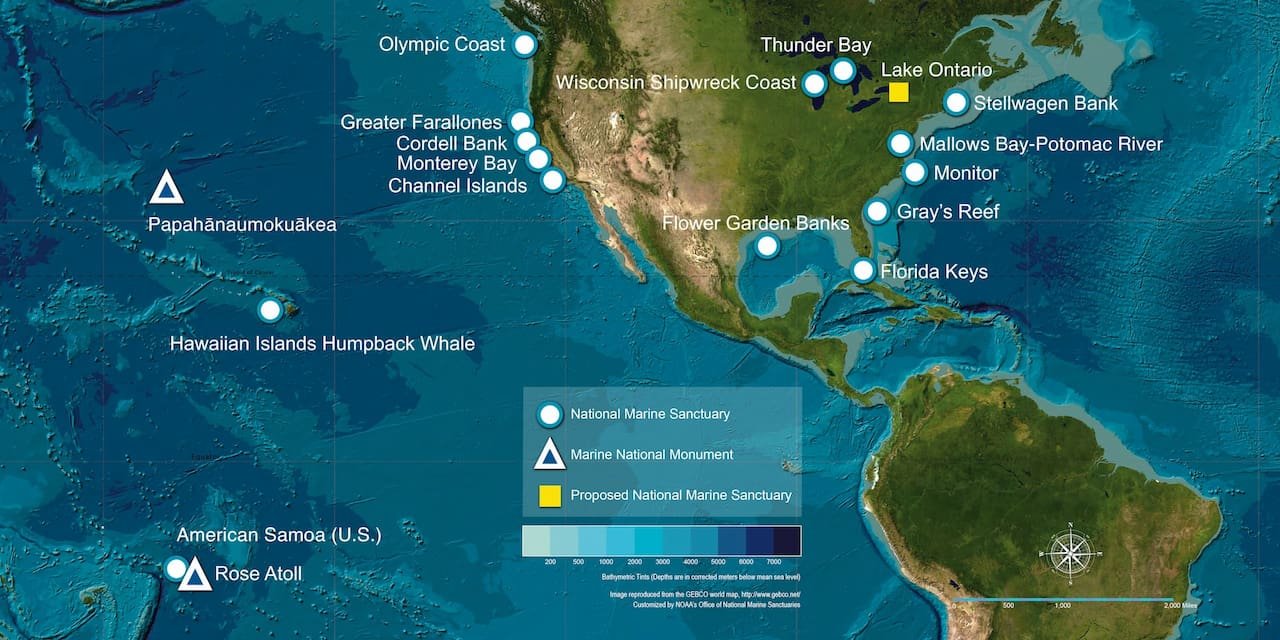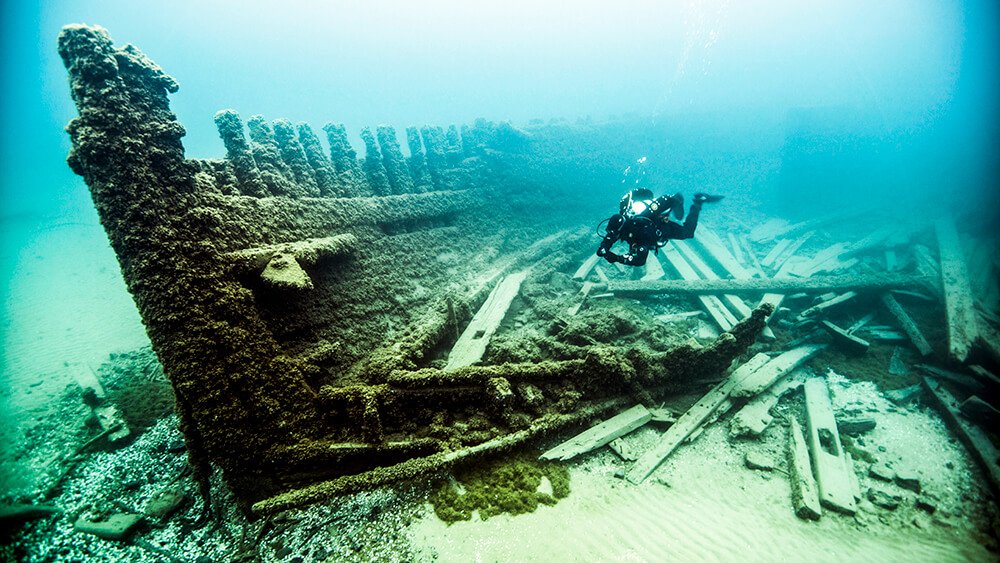What is a National Marine Sanctuary?
Every day the news is full of stories about the ways the health of the ocean is at risk. You may wonder if there is anything that can be done to protect it? Afterall, the ocean is an extremely valuable resource responsible for half the world’s oxygen and biological production, 15 percent of consumed protein, and 26 percent of the carbon dioxide absorbed. One way the US protects our marine environment dates back to 1972, when Congress passed into law the National Marine Sanctuaries Act. That bill authorized “the Secretary of Commerce to designate and protect areas of the marine environment with special national significance due to their conservation, recreational, ecological, historical, scientific, cultural, archeological, educational or esthetic qualities as national marine sanctuaries.”
What is a Marine Sanctuary?
A National Marine Sanctuary is an area within the territorial waters of the US that is afforded special protection for its recreational, ecological, historical, cultural, archeological, scientific, educational, or aesthetic qualities. The resources protected by the national marine sanctuary designation range from coral reef ecosystems to shipwrecks.
To date there are the 15 national marine sanctuaries and two National Marine Monuments. The Office of National Marine Sanctuaries acts as trustee for the more than 620,000 square miles of National Marine Sanctuary waters that exist from the state of Washington to the Florida Keys. These sanctuaries range in size from less than 1 square mile to more than 580,000 square miles.
There also are two National Marine Monuments: Papahānaumokuākea (Hawaii) and Rose Atoll (American Samoa).
Since President Richard Nixon signed the Marine Protection, Research, and Sanctuaries Act into law, it has remained the only legislation in the US “to address marine conservation in U.S. waters from a holistic, ecosystem perspective.” The full history of the National Marine Sanctuary System including stories for each individual marine sanctuary and national monument are contained in the publication Time and Tide. The publication is available free in pdf format from the Office of National Marine Sanctuaries. Click here.
Map displaying the network 14 national marine sanctuaries and the Papahānaumokuākea Marine National Monument
How Marine Sanctuaries are Designated?
The National Marine Sanctuaries Act is the only federal law written specifically to protect nationally significant areas in the ocean and Great Lakes. The act grants the National Oceanic and Atmospheric Administration (NOAA) with “the authority to develop management plans, issue regulations, and enforce those regulations for each sanctuary and the National Marine Sanctuary System as a whole.”
There is no requirement for who may nominate an area to be considered for National Marine Sanctuary status. According to the National Oceanographic and Atmospheric Administration’s (NOAA) office of National Marine Sanctuaries, successful nominations demonstrate broad support and identify the specific goal(s) or intent for nominating the area for National Marine Sanctuary status. The strongest nominations are those that provide “a clear connection and focus on the national significance criteria most relevant to the goal and intent for the nominated area and provide as much information as possible for those national significance criteria.” The nomination is limited to a maximum of 25 pages and must address detailed criteria as outlined in the application process materials. No appendices maybe be included; however, letters of support are encouraged and are not counted as part of the 25 page limit.
The nomination and designation process is both a public and participatory process. This is done to assure that a diversity of voices and community needs are evaluated. Stakeholders help determine whether the sanctuary merits designation and the size, boundaries, and resources to be protected.
The final designation of an area as a National Marine Sanctuary, as provided under the National Marine Sanctuaries Act (NMSA), can be made by either the Secretary of Commerce or by legislative authorization of Congress.
Chumash Heritage National Marine Sanctuary, a Case Study
The Central California Coast is recognized for its unique and rich resources from lush kelp forests to steep marine canyons teaming with life. This significant area is bookended by two previously designated national marine sanctuaries: the Monterey Bay National Marine Sanctuary to the north and the Channel Island National Marine Sanctuary to the south. The area in between these two national marine sanctuaries has for many lifetimes been stewarded by the Chumash Peoples and other tribes. The opportunity to connect the two existing national marine sanctuaries with a third would provide unparalleled protection for the area and become the first Tribal-nominated national marine sanctuary designation in the U.S. Such a sanctuary “would help to address the global biodiversity crisis and accelerate nature-based solutions through inclusive partnerships and collaboration among federal, state and local governments, and California Native American Tribes.”
The Northern Chumash Tribal Council in 2013 launched a campaign to secure formal sanctuary designation for a Chumash Heritage National Marine Sanctuary connecting the Monterey Bay National Marine Sanctuary and the Channel Islands Marine Sanctuary. Two years later the nomination was placed on an official list for future consideration. Chief Fred Collins of the Northern Chumash Tribal Council had a passionate commitment to the project. His daughter Council Chairwoman Violet Sage Walker carried on his work after his death in 2021. Within two months of Chief Collins passing, NOAA published a Notice of Intent that advanced the sanctuary designation process to the final stage, nearly ten years after the area was formally nominated for consideration.
In the words of Chief Fred Collins: “There is tremendous potential for good here. A Chumash Heritage National Marine Sanctuary will preserve and recognize the importance of our tribal history, safeguard our shared coastal resources, and open new doors for research and economic growth.”
National Marine Sanctuaries in the Great Lakes
National marine sanctuaries in the Great Lakes might seem odd because the term marine is generally associated with bodies of salt water. The Great Lakes, however, are fresh water. The five lakes (Huron, Ontario, Erie, Michigan, and Superior) that make up the Great Lakes contain more than 20 percent of the world’s surface freshwater.
A Marine Sanctuary by definition is an underwater area chosen for its significance and determined to deserve management that affords protection for its resources. The Great Lakes, like their marine coastal counterparts, contain many significant areas of natural ecosystems and cultural and historical resources that deserve sanctuary status. The Great Lakes and their connecting waterways have long served as an important byway for transportation and trade extending for more than a thousand miles. They have brought “hundreds of thousands of people to the Midwest and made possible the dramatic growth of the region’s farms, cities, and industries. Indeed, the Midwest and United States could not have developed with such vast economic success without the Great Lakes.”
The first of the Great Lake national marine sanctuaries was designed in 2000. The Thunder Bay National Marine Sanctuary, established in Lake Huron, protects a nationally significant collection of nearly 100 historic shipwrecks. The lake’s cold, fresh water offers an environment that ensures the shipwrecks are among the best preserved in the world.
The second Great Lake national marine sanctuary was designated in 2021. The Wisconsin Shipwreck Coast National Marine Sanctuary offers sanctuary to 36 historic shipwrecks in Lake Michigan. Twenty-seven are listed on the National Register of Historic Places and more than twice as many may still be discovered.
Three more sanctuaries are winding their way through the designation process. One is proposed for Lake Ontario in an eastern section of the lake and a portion of the St. Lawrence River. NOAA is currently putting together an environmental impact statement. If public comment is deemed favorable, the sanctuary will likely be designated. Another area in an early phase of consideration is in Lake Erie and a third is under consideration in a Lake Superior area off Whitefish Point. NOAA is currently reviewing the latter nomination and it may, as is the case with the Lake Erie nomination, be placed on an inventory list.
National Marine Monuments and National Marine Protected Areas
Currently, the National Marine Sanctuary System includes two marine national monuments. These are the Papahānaumokuākea Marine National Monument in the northwestern Hawaiian islands and the Rose Atoll Marine National Monument in American Samoa. The President of the US was given the authority to establish these national monuments under the Antiquities Act of 1906. The national marine monument designation protects and preserves natural or cultural landmarks of scientific or historical significance. The proclamation that creates a national monument also outlines the applicable regulations and agencies responsible for managing them. It is possible for a monument at a later date to become part of the National Marine Sanctuary System if it successfully navigates the National Marine Sanctuaries Nomination Process. The national marine sanctuary status strengthens protections afforded by the monument designation.
Additionally, the Office of National Marine Sanctuaries also leads the National Marine Protected Areas, “... any area of the marine environment that has been reserved by federal, state, territorial, tribal, or local laws or regulations to provide lasting protection for part or all of the natural and cultural resources therein.” MPAs is a broad term that encompasses a variety of conservation and management areas that include such federal programs as National Wildlife Refuges and partnership programs like the National Estuarine Research Reserves and overseen by a collection of federal, state, and regional agencies.





